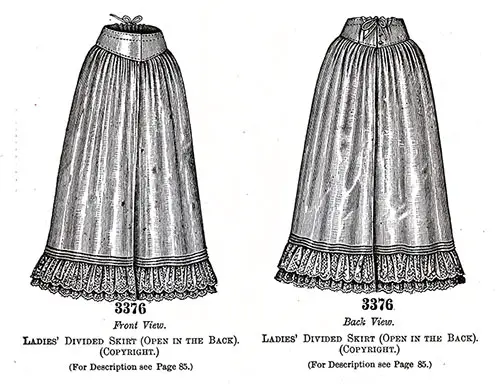Ladies Divided Skirt No. 3376 - 1890

No. 3376. — This skirt is illustrated made of Surah and trimmed with lace and tucks. (Open in the Back.)
It is preferred by many to the ordinary skirt, particularly for wear during stormy weather and for tricycling and other outdoor sports, as it affords perfect liberty to the limbs and imparts the same amount of warmth as the regular skirt.
The skirt is in two sections, which are deeply hemmed at the bottom and trimmed with two frills of lace below a cluster of small tucks.
The side edges of each section are joined by a seam that extends about a third of the way to the top, the free edges being finished with under facings. The upper edge is drawn by gathers and joined to a fitted yoke, which has a seam at the center of the front.
The outside and lining of the yoke are stitched together at the top to form a casing, in which at the back are inserted tapes to adjust the yoke to the size of the waist; and below the tapes, the yoke is closed with buttons and button-holes.
Dressmaker Options
Mohair, pongee, all-wool flannel, Farmer satin, Surah and various other fabrics will make up well by the mode; and lace, embroidery, fancy stitching, or any preferred decoration may be selected.
If tucks are desired, allowance must be made for them before cutting out the garment, as they are not considered in the pattern.
Pattern Information
We have pattern No. 3376 in nine sizes for ladies from twenty to thirty- six inches, waist measure.
For a lady of medium size, it will need eight and one-half yards of material twenty inches wide, or six yards and three-fourths, twenty-seven inches wide, or four yards and seven-eighths, thirty- six inches wide.
Price of pattern, 1s. or 25 cents.
"Ladies’ Divided Skirt [No. 3376]," in The Delineator: A Journal of Fashion, Culture, and Fine Arts – Midsummer Number, New York: Butterick Publishing Co., Ltd, Vol. XXXVI, No. 2, August 1890, P. 85 (For Illustrations see Page 87).
Note: We have edited this text to correct grammatical errors and improve word choice to clarify the article for today’s readers. Changes made are typically minor, and we often left passive text “as is.” Those who need to quote the article directly should verify any changes by reviewing the original material.
